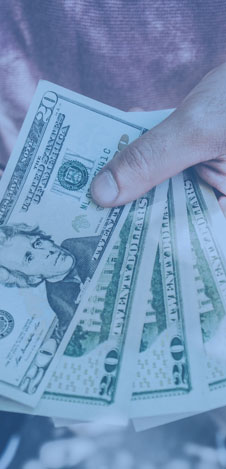Fasten Your Seatbelt — Updates
By Terry Savage on April 08, 2025
Update on Thursday, April 10
The shock of the original tariff announcement was equaled and exceeded by the stunning and unexpected reversal midday yesterday. From my viewpoint, this whole process has exposed a level of irresponsibility that is shocking. Only when the ability to borrow — refinance our debt at reasonable rates– was called into question, did the magnitude of the disaster become apparent. They were willing to let the stock market slide by 20% — but when bond market rates started rising in the midst of a 10-year Treasury refinancing, it really got their attention. Calling it “yips” is the understatement of the century.
IT IS NOT OVER YET! At this point on Thursday, the market is down 700 points after yesterdays nearly 3,000 point rally. Or to put it in perspective, you’re halfway back on your losses this week — so far!
This whipsaw validates my long-time advice to have enough money on the sidelines in “chicken money” — depending on your age, stage of life, and risk tolerance — so you don’t ever get caught up in panic selling, or buying.
That advice stands. No one has a crystal ball. But reality dictates that the economic ramifications of a 125% tariff (essentially a blockade) of Chinese goods will have ripple effects throughout the economy, creating both inflation and shortages — and leading us down the path to recession. Be prepared.
Update on Wednesday, April 9
This morning China retaliated with an 84% tariff on imports from the US. It will hit US farmers hard. We export $13 billion of soybeans to China — which they will now source from Brazil. The last round of tariffs in 2016, required $82 billion in federal price supports to farmers.
And the US import tariffs of 104% will hit you in places you likely never considered. Beyond iPhones and lululemon, we import 95% of our ibuprofen and 70% of acetaminophen from China! (Stock up on Tylenol!) Not to mention, many generic drugs (refill your statin prescription now!).
Even worse, China has accumulated a lot of dollars we paid them for the “stuff” we imported. They invested those dollars in U.S. Treasury debt — about $760 BILLION of our debt. Now there are concerns they will sell that debt, and not buy more. As a result, interest rates on the 10-year U.S. Treasury note (which had been yielding less than 4% on recession fears) jumped to over 4.5% overnight. Today there will be a 10-year Treasury auction. Watch the results closely. How will the U.S. finance its debt if the world doesn’t want to buy it???
*******************************************
In recent days you’ve been on a wild and bumpy ride in the stock market. And it’s not over yet. The first shock of the breadth and depth of the tariff announcement has passed. The market has staged rallies on hopes of deals that will restore balance and mitigate the impact on the economy.
But damage has been done. No matter what trade deals are done – and no matter whether China comes to the table – the impact will have long-lasting consequences.
Trade patterns around the world have been changed, and you can be sure that from Europe to South America, new deals are being struck – deals that leave America on the fringe.
Major American companies will take a while to re-allocate capital to manufacturing in the United States, assuming they can get raw materials and component parts at a reasonable cost. And assuming they can find labor in the U.S. to build their products at a reasonable cost.
Some small businesses will simply go out of business, unable to absorb the higher costs that go into their products. Some employers will cut jobs, as consumer spending slows and reallocates priorities.
The Stock Market and The Economy
The stock market reacts instantly. The economy will take longer to assess the impact – even if some tariffs are rescinded. That’s why it’s difficult to predict the effect on corporate sales and profits – the two things the market looks at to evaluate stock prices.
The stock market is always right – a lesson taught to me years ago by a wise old trader. And the corollary to that statement is that it’s unwise (unless you’re a full-time trader by profession) to try to “beat” the market.
Over the long run – the past 100 years — there has never been a 20-year period when you would have lost money in a diversified portfolio of large company American stocks with dividends reinvested, according to the Ibbotson market historians.
So your only question must be: How long is YOUR long run?
Your Investments
If you are under 45 and contributing regularly to your 40l(k) or similar retirement plan at work or in an IRA, then your time horizon should far exceed the 20-year historic “safe” period. You won’t retire for at least 20 years, and you’ll likely live another 20 years during your retirement.
In that case, you must keep investing into your plan — no matter how scary the stock market looks in any one month. Make it automatic and don’t disrupt the flow of money into the stock market. After all, your fixed $300 contribution buys more shares when prices are down!
If you’re closer to retirement, and the stock market gyrations are concerning, this is a good time to re-evaluate the investment choices inside your retirement plan – even while maintaining your exposure to the stock market.
Most 40l(k) plans don’t have a money market mutual fund as an alternative, because these plans are designed to grow your money over the long run for retirement. But many do have a short-term bond fund, or perhaps a more conservative stock fund, such as an equity-income fund.
If you’ve defaulted to a “target date” retirement fund inside your plan, be sure to take a look at exactly how conservatively that fund is invested. As you are just a few years from retirement, it may have a greater allocation to the stock market than makes you comfortable. It’s easy to switch some of that money to the short-term bond fund.
Advice for Retirees
Your entire investment perspective changes once you’re retired. Instead of benefiting from lower stock prices as you invest more money, you’re suddenly faced with the cold fact that this is it – all the money you’re ever going to have. Losing even a portion becomes extremely painful.
By now, you should have rolled out of your old company 40l(k) plan into an IRA, where you have a wider choice of investment alternatives, including a government securities money market fund. Haven’t rolled over yet? Read this column with rollover instructions.
It’s your job (or that of your trusted fiduciary advisor) to figure out the balance between the growth that stocks have always provided over the long run and the peace of mind you need to not panic at exactly the wrong time.
There’s an old stock market saying: “Sell down to the sleeping point.” That point is different for everyone, based not only on how much money you have in your retirement investments, but on your own personal risk tolerance. And you never really find that point of “risk tolerance” until the downside stares you in the face.
You just had a closeup look at risk. Bear markets have taken the market down 50% twice during this century – 2000, and 2007. That’s not a forecast; that’s history. No one knows the ultimate impact of today’s global readjustment on the U.S. stock market.
But at this stage of your life, are you willing to risk it? That’s the question to ask. And that’s The Savage Truth.



